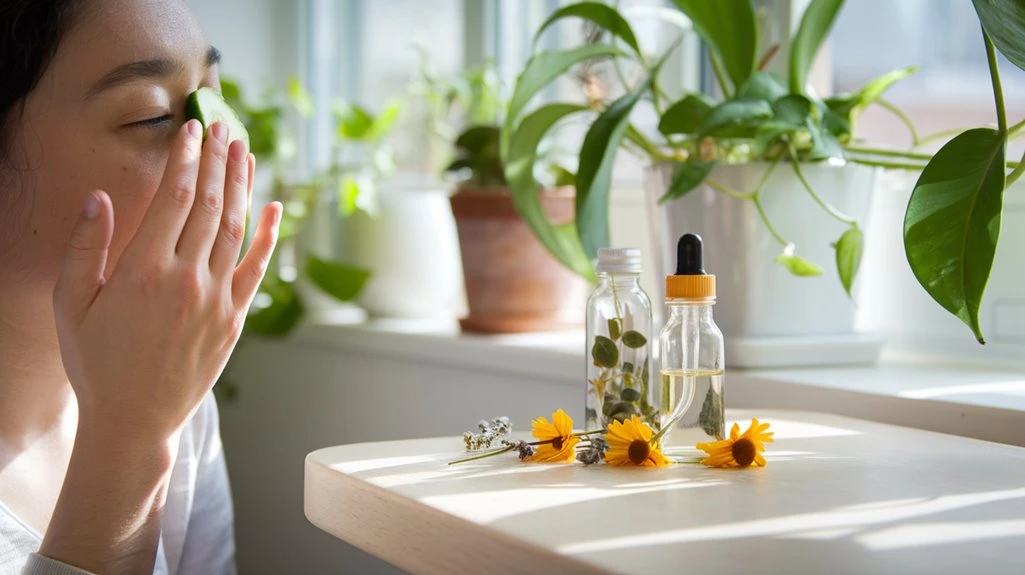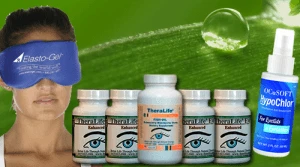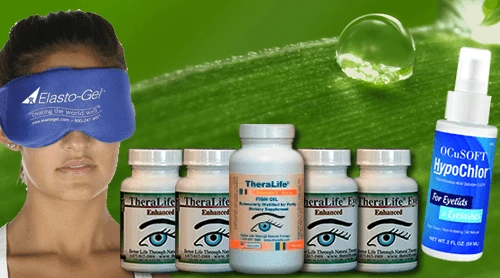If you’re experiencing eyelid irritation, TheraLife.com offers plant-based soothers- eyelid irritation that provide gentle anti-inflammatory, antioxidant, and moisturizing benefits. These natural products support the sensitive periocular barrier and reduce the risk of hypersensitivity often associated with synthetic agents. TheraLife’s offerings, including botanicals like chamomile and aloe vera, are known for their high tolerance levels and can be seamlessly integrated into daily routines to maintain eye comfort. By choosing TheraLife’s high-quality, standardized preparations, you can effectively manage conditions like blepharitis and dry eyes, while exploring how these natural solutions compare to synthetic options. Plus, TheraLife’s extensive resources guide you on safely integrating these products into your regimen, ensuring your eyes remain comfortable and healthy.
Best Plant Based Eyelid Irritation/Blepharitis Treatment From TheraLife- When Drops Don’t Work.
Key Takeaways
- Plant-based eyelid irritation soothers offer gentle anti-inflammatory and antioxidant effects, reducing irritation without overstimulating sensitive eyelid skin.
- Botanical remedies are often hypoallergenic, making them suitable for individuals prone to allergic reactions or with sensitive periocular areas.
- Many plant extracts support skin barrier function and enhance moisture retention, protecting delicate eyelid irritation tissue from dryness.
- Herbal options may pose fewer risks of adverse effects compared to some synthetic agents, especially in long-term use.
- Choosing reputable plant-based products ensures safer alternatives that supplement regular eyelid hygiene and medical treatments.
Understanding the Link Between Plants and Skin Health
Although plant-derived compounds frequently appear in topical formulations, scientific evidence directly linking plant extracts to improved eyelid skin health remains inconclusive.
You’ll find that plant compounds such as polyphenols, flavonoids, and terpenes have demonstrated antimicrobial or anti-inflammatory actions in vitro, but rigorous clinical trials evaluating their efficacy specifically on eyelid skin are limited.
The eyelid’s unique anatomical features and its sensitive skin microbiome warrant targeted investigation before generalizing findings from studies on other skin sites.
You should recognize that while these compounds might modulate the skin microbiome or barrier function, their direct effects on eyelid irritation, hydration, or microbial balance require further elucidation.
As you consider plant-based soothers, it’s prudent to prioritize evidence-backed approaches and be aware of potential sensitivities or allergic responses unique to eyelid irritation tissue.
In conditions like rheumatoid arthritis, ocular manifestations can include dry eyes and other inflammatory eye conditions, emphasizing the importance of properly addressing eye health.
Key Benefits of Botanical Ingredients for Eyelid Comfort
You may find that botanical ingredients provide gentle anti-inflammatory effects, reducing eyelid redness and swelling with minimal risk of sensitization. These plant-based compounds can offer antioxidant protection, mitigating oxidative stress implicated in periocular discomfort. Additionally, you’re likely to achieve enhanced moisturization without provoking eyelid irritation, supporting barrier function in sensitive eyelid skin. For those with chronic dry eyes, comprehensive treatments like the TheraLife® Dry Eye Starter Kit can offer rapid symptom relief while promoting sustainable tear restoration.
Gentle Natural Anti-inflammatories
Several botanical compounds, such as chamomile, calendula, and green tea extract, have demonstrated anti-inflammatory properties that may contribute to eyelid irritation comfort.
When you seek gentle relief, plant extracts and herbal infusions present a promising strategy. These natural agents interact with the skin’s surface, modulating inflammatory mediators without the harsh side effects sometimes seen with synthetic ingredients.
Clinical studies suggest that these botanicals can reduce swelling, redness, and discomfort associated with eyelid irritation.
- Chamomile contains apigenin, a flavonoid linked with inflammation reduction.
- Calendula provides triterpenoids, supporting skin repair and soothing effects.
- Green tea extract is rich in polyphenols, minimizing visible redness.
- Plant extracts may offer hypoallergenic profiles for sensitive skin.
- Herbal infusions can support barrier function and moisture retention.
Consider incorporating these gentle options cautiously. Additionally, Theralife products offer a natural approach to blepharitis management, reducing reliance on artificial tears and improving meibomian gland function.
Antioxidant Protection Benefits
Antioxidants play an essential role in neutralizing free radicals that contribute to eyelid irritation and oxidative stress. When you use plant-based soothers, you’re drawing from antioxidant sources like green tea extract, chamomile, and calendula, all of which have been shown in clinical studies to mitigate cellular damage.
These botanical compounds limit the cascade of oxidative injury that can degrade sensitive periorbital skin. Incorporating such ingredients into your eyelid care regimen may support skin rejuvenation by preserving cellular integrity and modulating inflammatory pathways. Herbal solutions provide natural alternatives for managing epiphora, focusing on treating underlying causes rather than symptoms of eyelid irritation.
Medical literature suggests that regular topical antioxidant application can enhance cutaneous defense mechanisms without compounding irritation. For patients with sensitive or reactive skin, prudently selected botanical antioxidants provide a non-overstimulating adjunct to conventional management.
Always consult your ophthalmologist or dermatologist before adding new topical agents.
Moisturizing Without Irritation
Although eyelid skin is among the thinnest and most sensitive on the body, botanical moisturizers such as aloe vera, cucumber extract, and oat beta-glucan demonstrate low sensitization potential and effective hydration.
Using these plant-based ingredients enables you to support moisture retention while minimizing your risk for adverse skin reactions. Their bioactive compounds promote irritation relief without occlusive or allergenic effects typical of synthetic formulations.
Consider these clinically demonstrated benefits:
- Enhanced skin barrier function for sustained hydration
- Reduction of erythema and pruritus associated with dryness
- Non-comedogenic profiles prevent pore blockage near the lash line
- Phytochemicals offer synergistic calming and anti-inflammatory actions
- Rapid absorption maintains lightweight comfort on delicate eyelid tissue
It is important to maintain eyelid cleanliness as part of your skincare routine to support the use of botanical moisturizers in reducing blepharitis symptoms.
With botanical soothers, you achieve moisture retention and irritation relief while respecting the sensitivity of your eyelid skin.
Best Plant Based Eyelid Irritation/Blepharitis Treatment From TheraLife- When Drops Don’t Work.
Common Plant-Based Remedies Used for Blepharitis
You may consider evidence supporting chamomile for its mild anti-inflammatory and calming properties in managing blepharitis symptoms. Aloe vera also shows potential for soothing periocular irritation due to its hydrating and barrier-supporting effects. It’s crucial to use pharmaceutical-grade preparations and monitor for allergic reactions. Hypochlorous acid solutions are effective against microbial agents, making them a valuable addition to blepharitis treatment strategies.
Chamomile’s Calming Properties
Despite its traditional reputation for soothing irritated skin, chamomile’s efficacy and safety in treating blepharitis remain unproven in clinical research. You might encounter recommendations to use chamomile tea compresses or diluted chamomile oil for eyelid irritation due to chamomile’s anti-inflammatory and antioxidant properties.
However, consider that there are documented risks of allergic conjunctivitis and contact dermatitis, especially in individuals with sensitivities to Asteraceae plants. Clinical literature has yet to support chamomile as a validated adjunct for blepharitis care.
- Warm chamomile tea bags are applied as eyelid compresses.
- Chamomile oil is sometimes diluted for topical eyelid use.
- Anti-inflammatory effects are theorized, not established.
- Allergic reactions can occur, particularly in sensitive individuals.
- No standardized dosing or preparations for blepharitis exist.
Exercise caution and consult your ophthalmologist before use. Regular eye check-ups help detect early signs of dry eye syndrome and monitor overall eye health.
Aloe Vera Soothing Effects
While aloe vera’s reputation as a skin soother leads some patients to contemplate it for eyelid irritation, current evidence doesn’t support its routine use in managing blepharitis. Although aloe vera demonstrates skin hydration and anti-inflammatory properties in dermatologic studies, such findings haven’t translated to proven efficacy or safety for the delicate eyelid margin. You may find anecdotal reports suggesting benefit, but these lack scientific validation and carry potential risks, including allergic reaction or further irritation. Considering the eye’s anatomical sensitivity, it’s prudent to avoid unsupervised application of aloe vera near the ocular surface. If you’re seeking symptom relief for blepharitis, established, ophthalmologist-recommended regimens—such as eyelid hygiene with preservative-free cleansers—remain the evidence-based standard. Regular eyelid hygiene is crucial to minimize symptom recurrence and ensure proper eyelid health. Consult your provider before using any plant-based agent.
Safety and Side Effect Profile of Herbal Soothers
Although many individuals seek herbal soothers for eyelid irritation due to their perceived gentleness, clinicians should recognize that these remedies carry potential safety concerns and side effects. When evaluating herbal safety, you must consider not only the pharmacological properties but also patient-specific factors such as history of hypersensitivity or ocular disease. The evidence base suggests a risk of local and systemic responses that warrant attention. Even generally well-tolerated botanicals may not be uniformly innocuous. The following list illustrates key aspects of the side effect profile associated with plant-based soothers:
- Local allergic reactions, including contact dermatitis and conjunctival irritation
- Systemic hypersensitivity reactions, rare but documented
- Contamination risk from poorly regulated herbal preparations
- Potential interactions with existing ophthalmic medications
- Delay in medical treatment due to misperception of herbal safety
In the case of Meibomian Gland Dysfunction, the use of herbal treatments should be considered with caution, as this condition can exacerbate symptoms like dry eyes and irritation.
How to Incorporate Plant-Based Solutions Into Your Routine
When considering the integration of plant-based soothers into your ocular care regimen, start with a thorough evaluation of both product quality and personal risk factors such as allergy history or concurrent eye conditions. Consult with an ophthalmic professional before initiating any new herbal preparations, particularly if you have preexisting sensitivities or are using prescription therapies. Choose standardized, reputable products with transparent ingredient lists to minimize variability and contamination risk. Incorporate these soothers into your daily rituals by applying them during established routines—such as after cleansing your face or before bedtime—to enhance adherence and consistency. Monitor for any adverse reactions, including redness or increased irritation, and discontinue use if symptoms worsen. Always document your response to guarantee peak safety and sustained benefit within your ocular care protocol. Adding omega-3 fatty acids to your regimen may also provide anti-inflammatory benefits and improve dry eye symptoms.
Comparing Plant-Based and Synthetic Approaches for Eye Care
Given the array of available options, distinguishing between plant-based and synthetic remedies for eyelid irritation requires close attention to both efficacy and safety profiles.
When you assess eye care solutions, consider how natural remedies with plant extracts compare to traditional synthetic ingredients. Plant-based formulations frequently offer anti-inflammatory benefits and a reduced risk of hypersensitivity reactions, based on emerging clinical data.
Synthetic agents may deliver rapid symptom relief, but they often carry a higher potential for adverse effects or ocular surface disruption.
- Plant extracts such as chamomile and calendula demonstrate soothing properties.
- Synthetic actives may involve preservatives or stabilizers that can cause irritation.
- Natural remedies tend to preserve tear film integrity.
- Synthetic alternatives are more likely to produce contact dermatitis.
- Ophthalmologists often recommend patch tests before initiating either approach.
Best Plant Based Eyelid Irritation/Blepharitis Treatment From TheraLife- When Drops Don’t Work.
Frequently Asked Questions
Can Children Safely Use Plant-Based Eyelid Soothers?
You should approach children’s safety with caution when considering plant-based eyelid soothers.
While natural remedies can minimize exposure to synthetic compounds, they’re not automatically risk-free. Children’s skin and immune systems are sensitive, so you must assess each product’s ingredients for potential allergens or irritants.
Consult a pediatrician or ophthalmologist before use, as current evidence doesn’t guarantee universal safety or efficacy.
Prioritize patch testing and clinical guidance to prevent adverse reactions.
Are Plant-Based Soothers Effective for Chronic Eyelid Conditions?
When you’re managing chronic eyelid conditions, you might consider plant-based soothers as natural alternatives.
Clinical evidence suggests some botanical agents—like chamomile and calendula—exhibit anti-inflammatory and antimicrobial properties. However, research on their long-term efficacy is limited.
You should use these products cautiously, especially if you have allergies or persistent symptoms. It’s best to consult your healthcare provider before relying solely on natural alternatives for chronic conditions, ensuring safety and ideal outcomes.
How Should Plant-Based Soothers Be Stored to Maintain Potency?
Wondering how to optimize storage methods for plant-based soothers and guarantee potency preservation?
You’ll need to store them in a cool, dry place away from direct sunlight, as elevated temperatures and light accelerate degradation of active botanical components.
Seal the container tightly to minimize air and moisture exposure. Always check expiration dates, and avoid transferring contents to unsterile containers, since contamination may compromise efficacy.
Follow manufacturer guidelines for best clinical outcomes.
Can I Make Plant-Based Soothers at Home Safely?
You can create plant-based soothers at home using homemade recipes, but you must prioritize safety precautions.
Always select pharmaceutical-grade, evidence-based ingredients, and maintain aseptic technique to reduce microbial contamination risk. Avoid known allergens and perform a patch test before ocular application.
Sterilize all utensils and storage containers. If you experience persistent irritation, discontinue use and consult an ophthalmologist.
Homemade preparations lack clinical validation, so exercise extreme caution to protect ocular health.
Will Plant-Based Soothers Interfere With Prescription Eye Medications?
You should exercise caution when combining plant-based soothers with prescription eye medications.
Certain plant-based interactions may alter medication absorption or efficacy. Although research is limited, compounds in plant extracts might affect drug metabolism or cause unforeseen side effects.
To minimize potential risks, consult your ophthalmologist before using any adjunct plant-based product. Don’t self-medicate, as individual responses differ and current evidence doesn’t guarantee safety regarding pharmacokinetic or pharmacodynamic interactions.
Best Plant Based Eyelid Irritation/ Blepharitis Treatment From TheraLife- When Drops Don’t Work.
Conclusion
If you’re considering options for eyelid irritation, TheraLife offers plant-based soothers that can be beneficial for your needs. These products harness the power of botanical remedies like calendula and chamomile, known for their anti-inflammatory effects and minimal adverse events. TheraLife’s approach ensures that these natural solutions effectively support eyelid homeostasis, promoting relief and comfort for those experiencing conditions like blepharitis, dry eyes, or chalazion.
TheraLife’s comprehensive range of products is designed to cater to individual needs, providing targeted relief and supporting overall eye health. By focusing on natural, plant-based ingredients, TheraLife minimizes the risk of adverse reactions, making their solutions suitable for a wide audience. Additionally, they offer guidance on proper usage and encourage consulting with an ophthalmologist to tailor interventions to your unique clinical presentation.
Moreover, TheraLife’s commitment to holistic care extends to lifestyle and dietary recommendations that complement their product offerings. Whether you’re dealing with recurrent eye issues or seeking preventive care, TheraLife provides a well-rounded approach to maintaining eye health, ensuring that their customers receive the most effective and safe treatments available.





